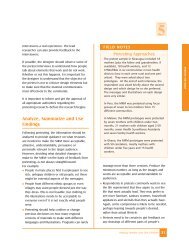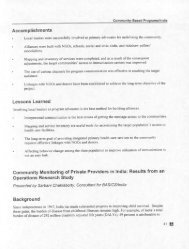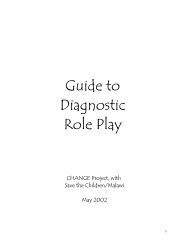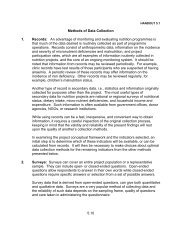MODULE TWO: COUNSELLING - FHI 360 Center for Global Health ...
MODULE TWO: COUNSELLING - FHI 360 Center for Global Health ...
MODULE TWO: COUNSELLING - FHI 360 Center for Global Health ...
Create successful ePaper yourself
Turn your PDF publications into a flip-book with our unique Google optimized e-Paper software.
Anxiety about bodily changes (Am I normal?)<br />
Feelings about self (Self Esteem)<br />
Feelings about others (same sex peers, opposite sex peers, parents of opposite<br />
sex, siblings of opposite sex)<br />
Anxieties about behaviour (sexual behaviour with same sex and sexual behaviour<br />
with opposite sex).<br />
FACTORS THAT INFLUENCE ADOLESCENTS SEXUAL BEHAVIOR<br />
As a result of the physical and emotional changes associated with adolescence,<br />
many difficulties arise. These difficulties also differ from one culture to another.<br />
Besides the impact of the changes in each adolescent, one can also consider<br />
anxieties that adults may have regarding the new potential <strong>for</strong> pregnancy which<br />
comes with the development of the reproductive systems and the risk of STIs<br />
and HIV from behavioral changes. Recent data indicates that up to 60 per cent<br />
of new HIV infections are among 15 –24 year olds, with females outnumbering<br />
males by a ratio of two to one.<br />
Young people’s maturation process is influenced by their surroundings and<br />
affected by relationships with key people such as parents, teachers and peers.<br />
Several factors influence sexual behavior during the adolescent years.<br />
a) Peer group influence<br />
b) Social Norms<br />
c) Religion and traditions<br />
d) Gender<br />
e) Socioeconomic factors<br />
Peer Groups<br />
Peer groups increase in importance and influence during adolescence, as friends<br />
are a powerful source of in<strong>for</strong>mation and shape the way young people behave.<br />
Social influence theories suggest that because group and individual norms and<br />
attitudes shape behavior, it is helpful <strong>for</strong> people to identify social pressures and<br />
then develop individual and group values that support health and appropriate<br />
behaviors.<br />
Social Norms<br />
As young people enter puberty, their interest in sex increases. At the same time<br />
they experience strong, often conflicting emotions and social pressures as they<br />
move away from childhood dependence towards more independent adulthood.<br />
In many cases current social norms reward boys but punish girls <strong>for</strong> having sex;<br />
mass media glamorizes irresponsible sex but reject young people’s interest in<br />
sexuality.<br />
Session 8-Pg.2
















